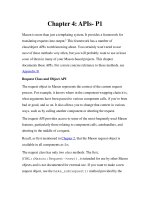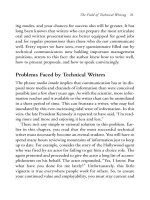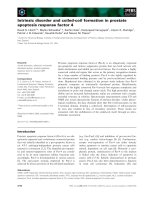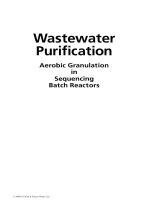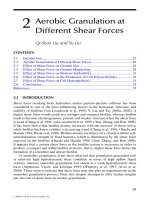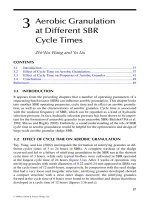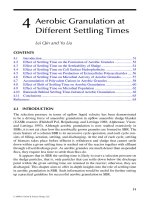Wastewater Purification: Aerobic Granulation in Sequencing Batch Reactors - Chapter 4 ppt
Bạn đang xem bản rút gọn của tài liệu. Xem và tải ngay bản đầy đủ của tài liệu tại đây (436.89 KB, 17 trang )
51
4
Aerobic Granulation at
Different Settling Times
Lei Qin and Yu Liu
CONTENTS
4.1 Introduction 51
4.2 Effect of Settling Time on the Formation of Aerobic Granules 52
4.3 Effect of Settling Time on the Settleability of Sludge 54
4.4 Effect of Settling Time on Cell Surface Hydrophobicity 55
4.5 Effect of Settling Time on Production of Extracellular Polysaccharides 56
4.6 Effect of Settling Time on Microbial Activity of Aerobic Granules 57
4.7 Accumulation of Polyvalent Cations in Aerobic Granules 58
4.8 Effect of Shift of Settling Time on Aerobic Granulation 60
4.9 Effect of Settling Time on Microbial Population 62
4.10 Rationale Behind Settling Time-Initiated Aerobic Granulation 62
4.11 Conclusions 65
References 65
4.1 INTRODUCTION
The selection pressure in terms of upow liquid velocity has been demonstrated
tobeadrivingforceofanaerobicgranulationinupowanaerobicsludgeblanket
(UASB) reactors (Hulshoff Pol, Heijnekamp, and Lettinga 1988; Alphenaar, Visser,
andLettinga1993).Althoughaerobicgranulationisnowstudiedextensivelyin
SBRs,itisnotyetclearhowtheaerobicallygrowngranulesareformedinSBR.The
mainfeatureofacolumnSBRisitssuccessivecycleoperation,andeachcyclecon-
sistsoflling,aeration,settling,anddischarging.Attheendofeachcycle,settling
of biomass takes place before efuent is withdrawn and sludge that cannot settle
down within a given settling time is washed out of the reactor together with efuent
through a xed discharge port. As aerobic granules are much denser than suspended
ocs,theyrequirelesstimetosettlethanocsdo.
ItappearsthatinSBRthesettlingtimeislikelytoexertaselectionpressureon
the sludge particles, that is, only particles that can settle down below the discharge
pointwithinthegivensettlingtimeareretainedinthereactor;otherwise,theyare
discharged. This chapter aims to offer in-depth insights into the role of settling time
in aerobic granulation in SBR. Such information would be useful for further setting
upapracticalguidelineforsuccessfulaerobicgranulationinSBR.
53671_C004.indd 51 10/29/07 7:14:29 AM
© 2008 by Taylor & Francis Group, LLC
© 2008 by Taylor & Francis Group, LLC
52 Wastewater Purification
4.2 EFFECT OF SETTLING TIME ON THE FORMATION OF
AEROBIC GRANULES
Qin,Liu,andTay(2004a)investigatedtheeffectofsettlingtimeonaerobicgranu-
lationinfourcolumnreactors,namelyR1,R2,R3,andR4,eachwithaworking
volume of 2.5 liters, which were operated in sequencing batch mode (gure 4.1). R1
toR4wererunatsettlingtimesof20,15,10,and5minutes,respectively,whilethe
other operation parameters were kept the same. The duration of different operation
stages and operation conditions applied for different reactors are shown in table 4.1.
Efuent was discharged at the middle point of each SBR, which gives a volume
exchangeratioof50%.Thesequentialoperationofthereactorswasautomatically
controlled by timers, while two peristaltic pumps were employed for inuent feeding
andefuentwithdrawal.Inordertolookintotheeffectofsettlingtimeonaerobic
Settling Height
Reactor
Timer
Effluent
Influent
Air
Peristaltic Pump
Peristaltic Pump
Air Pump
FIGURE 4.1 Schematic diagram of experimental system. (From Qin, L. 2006. Ph.D. thesis,
Nanyang Technological University, Singapore. With permission.)
TABLE 4.1
Operation Strategies of R1 to R4
Operation Time (min) R1 R2 R3 R4
Feed 5555
Aeration 210 215 220 230
Settling 20
5
15
2
10
1
5
—
Discharge 5555
Total cycle time 240 240 240 240
Minimal settling velocity (m h
–1
) 1.89 2.52 3.78 7.56
Source: Qin, L. (2006) Ph.D. thesis, Nanyang Technological University,
Singapore. With permission.
53671_C004.indd 52 10/29/07 7:14:30 AM
© 2008 by Taylor & Francis Group, LLC
© 2008 by Taylor & Francis Group, LLC
Aerobic Granulation at Different Settling Times 53
granulation,intherstphaseofthestudy,R1toR4wererunatrespectivesettling
timesof20,15,10,and5minutes.
Theseedsludgehadameanocsizeof0.11mm,andasludgevolumeindex
(SVI)valueof230mLg
–1
.After7daysofoperation,aerobicgranuleswererst
observed in R4 operated at the settling time of 5 minutes. On day 10, tiny aggregates
appearedinR1toR3runatrespectivesettlingtimesof20,15,and10minutes.After
3 weeks of operation, the four reactors reached steady state. The respective biomass
concentrations in R1 to R4 at steady state were 5.3, 4.9, 5.5, and 5.4 g L
–1
.Figure4.2
shows that aerobic granules had a very regular and spherical outer shape, and the
size of mature aerobic granules seems to increase gradually with the decrease of the
settlingtime.Kimetal.(2004)alsoreportedthatgranulescultivatedwithamini
-
mumsettlingvelocityof0.7mh
–1
hadameansizeof1to1.35mm,whereasgranule
sizevariedfrom0.1to0.5mmandrarelyexceeding1mmwhencultivatedwitha
lower minimum settling velocity of 0.6 m h
–1
. Other studies also showed that settling
time employed would have an impact on the formation, size, and structure of aerobic
granulesatsteadystate(Beun,vanLoosdrecht,andHeijnen2002;McSwain,Irvine,
andWilderer2004).
One of the prominent differences between aerobic granules and suspended ocs
is the magnitude of the micropellets. It is observed that in R1, R2, and R3 aerobic
granulescoexistedwithsuspendedocs,whereasinR4largeaerobicgranules
became dominant over suspended ocs. The fractions of aerobic granules in steady-
stateR1toR4areshowningure4.3.ItisobviousthatonlyinR4runattheshortest
AB
CD
FIGURE 4.2 Morphology of aerobic granules developed in R1 (a), R2 (b), R3 (c), and R4 (d). Bar:
2mm.(FromQin,L.,Liu,Y.,andTay,J.H.2004a.Biochem Eng J 21:47–52.Withpermission.)
53671_C004.indd 53 10/29/07 7:14:32 AM
© 2008 by Taylor & Francis Group, LLC
© 2008 by Taylor & Francis Group, LLC
54 Wastewater Purification
settling time of 5 minutes were aerobic granules the dominant form of growth;
whereasthefractionofaerobicgranuleswasonlyabout10%inR1,15%inR2,
and 35% in R3. These results clearly indicate that a mixture of aerobic granules and
suspendedsludgedevelopedinR1toR3insteadofapureaerobicgranularsludge
blanketasobservedinR4.Thefractionsofaerobicgranulesinthereactorsseemto
berelatedtothesettlingtimes.McSwain,Irvine,andWilderer(2004)alsoobserved
a similar phenomenon in two SBRs operated at different settling times of 2 and
10minutes,respectively.Atalongersettlingtime,poorlysettlingocscannotbe
effectively withdrawn, and they may outcompete granule-forming bioparticles. As a
result, the longer settling time would lead to failure of aerobic granulation due to the
absence of strong selection pressure.
4.3 EFFECT OF SETTLING TIME ON THE
SETTLEABILITY OF SLUDGE
SVI has been commonly used to describe the settleability and compactness of acti-
vated sludge in the eld of environmental engineering. Figure 4.4 shows the rela
-
tionshipbetweenthesettlingtimeandSVIobservedinsteady-stateR1toR4.Itwas
foundthattheSVIwascloselyrelatedtothesettlingtime,thatis,amorecompact
microbialstructureoftheaerobicgranulescouldbeexpectedatashortersettling
time. The SVI decreased from 230 mL g
–1
in seed sludge to 49 mL g
–1
in R4 after
the formation of aerobic granules. However, in SBRs with partial aerobic granulation
(R1toR3),theSVIwasmuchhigherthanthatinR4.Inconsiderationofthefraction
ofaerobicgranulesineachreactor(gure4.3),itisreasonabletoconsiderthat
theSVIisdeterminedbythedegreeofaerobicgranulationaswellasthesizeand
densityofaerobicgranules.McSwain,Irvine,andWilderer(2004)reportedthat
aerobicgranulesdevelopedintheSBRoperatedatasettlingtimeof2minuteshad
anSVIof47mLg
–1
, while an SVI of 115 mL g
–1
wasfoundfortheocculentSBR
Settling Time (min)
3 6 9 12 15 18 21
Fraction of Aerobic Granules (%)
0
20
40
60
80
100
120
FIGURE 4.3 Fraction of aerobic granules developed at different settling times. (Data from
Qin,L.,Liu,Y.,andTay,J.H.2004a.Biochem Eng J 21: 47–52.)
53671_C004.indd 54 10/29/07 7:14:33 AM
© 2008 by Taylor & Francis Group, LLC
© 2008 by Taylor & Francis Group, LLC
Aerobic Granulation at Different Settling Times 55
operatedatasettlingtimeof10minutes.Theimprovementofsettlingabilitywith
decrease of settling time can be attributed to the increase of size and number or
so-calledfractionofaerobicgranulesinthereactorsasocsareeffectivelywashed
out at short settling time.
4.4 EFFECT OF SETTLING TIME ON
CELL SURFACE HYDROPHOBICITY
Figure4.4showstheeffectofsettlingtimeoncellsurfacehydrophobicity.Alowcell
surfacehydrophobicitywasfoundtobeassociatedwithalongsettlingtime.Thecell
surfacehydrophobicitytendedtoincreasefrom20%fortheseedsludgetoastable
valueof48%inR1,58%inR2,63%inR3,and72%inR4.Likely,thecellsurface
hydrophobicity is inversely related to the settling time, that is, the microbial com
-
munity developed at short settling time exhibits a high cell surface hydrophobicity.
Asshowningure4.3,thepartialaerobicgranulationwasobservedinR1,R2,and
SVI (mL g
–1
)
40
60
80
100
120
140
160
Settling Time (min)
0 5 10 15 20 25
Cell Surface Hydrophobicity (%)
45
50
55
60
65
70
FIGURE 4.4 Effect of settling time on SVI (D) and cell surface hydrophobicity ($). (Data
fromQin,L.,Liu,Y.,andTay,J.H.2004a.Biochem Eng J 21: 47–52.)
53671_C004.indd 55 10/29/07 7:14:34 AM
© 2008 by Taylor & Francis Group, LLC
© 2008 by Taylor & Francis Group, LLC
56 Wastewater Purification
R3,whereasaerobicgranulesweredominantinR4.Itappearsthattheselection
pressure-induced change in cell surface hydrophobicity contributes to cell-to-cell
aggregation.Infact,ithasbeenwellknownthatcellsurfacehydrophobicityhighly
contributestotheformationofbiolmandanaerobicgranules(seechapter9).
Evidence shows that bacteria can change their surface hydrophobicity under
somestressfulconditions(seechapter9).Thecellsurfacehydrophobicityofthe
seed sludge was about 20%; however, after the appearance of aerobic granules in
R1toR4,thecellsurfacehydrophobicitywasgreatlyimproved(gure4.4).InR4
dominatedbyaerobicgranules,thecellsurfacehydrophobicitywasmuchhigher
thanthoseinR1toR3.Thesettlingtimeseemstoinducechangesincellsurface
hydrophobicity,andashortersettlingtimeorastrongerhydraulicselectionpressure
resultsinamorehydrophobiccellsurface.Researchonanaerobicgranulationalso
showed that anaerobic granular sludge in UASB reactors was more hydrophobic than
the nongranular sludge washed out (Mahoney et al. 1987). It seems that microbial
associationhastoadaptitssurfacepropertiestoresistbeingwashedoutfromthe
reactors through microbial self-aggregation at short settling time.
4.5 EFFECT OF SETTLING TIME ON PRODUCTION OF
EXTRACELLULAR POLYSACCHARIDES
Extracellularpolysaccharides(PS)areproducedbymostbacteriaoutofcellwall
with the purpose of providing cells with the ability to compete in a variety of
environments,providingamodeforadhesiontosurfaceorself-immobilization(see
chapter 10). Figure 4.5 shows that a shortened settling time would stimulate the pro
-
ductionofPS,forexample,anincreasefrom60.0to166.2mgg
–1
volatile solids
(VS) was observed in the mature granules with the decrease of settling time in R1
to R4, whereas the production of extracellular proteins (PN) was not signicantly
inuencedbythesettlingtime,rangingfrom16.5to25.0mgg
–1
VS. It appears
Settling Time (min)
0 5 10 15 20 25
PS/PN (mg mg
–1
)
3
4
5
6
7
8
FIGURE 4.5 Effect of settling time on PS/PN ratio. (Data from Qin, L., Liu, Y., and
Tay, J. H. 2004b. Process Biochem 39: 579–584.)
53671_C004.indd 56 10/29/07 7:14:36 AM
© 2008 by Taylor & Francis Group, LLC
© 2008 by Taylor & Francis Group, LLC
Aerobic Granulation at Different Settling Times 57
from gure 4.5 that the PS/PN ratio was inversely correlated to the settling time,
that is, a shorter settling time would stimulate cells to produce more polysaccharide.
Together with gure 4.3, these seem to suggest that extracellular polysaccharides
playanessentialroleintheformationandfurthermaintainingthestructureand
stabilityofaerobicgranules.
ThePS/PNratiosintheaerobicgranulescultivatedinR2toR4aremuchhigher
than that in the seed sludge (about 0.5 mg mg
–1
). This is consistent with the earlier
nding by Vandevivere and Kirchman (1993) that the content of extracellular poly
-
saccharides for attached cells was ve times higher than for free-living cells. The
failureofaerobicgranulationinSBRwasalsoobservedduetotheinhibitionof
the production of extracellular polysaccharides (Yang, Tay, and Liu 2004), while
thedisappearanceofaerobicgranulesinSBRwasfoundtobetightlycoupledtoa
drop of extracellular polysaccharides (Tay, Liu, and Liu 2001). It has been reported
thathighshearforcecaninducebothaerobicbiolmsandgranulestosecretemore
extracellular polysaccharides, leading to a balanced structure of biolm or granules
under given hydrodynamic conditions (Ohashi and Harada 1994; Tay, Liu, and Liu
2001;LiuandTay2002).Infact,thereiscontroversialreportwithregardtothe
essential role of extracellular polysaccharides in aerobic granulation (chapter 10).
4.6 EFFECT OF SETTLING TIME ON MICROBIAL ACTIVITY OF
AEROBIC GRANULES
Microbialactivitycanbequantiedbythespecicoxygenutilizationrate(SOUR)in
termsofmilligramsofoxygenconsumedpermilligramofvolatilebiomassperhour.
To reect the microbial activity of aerobic granules, aerobic granules were sampled
justduringthehalfhourofreactionperiod,andSOURwasmeasuredimmediately
after sampling (Qin, Liu, and Tay 2004a). The correlation between the SOUR and
settlingtimeispresentedingure4.6.TheSOURwasfoundtobeinverselyrelated
Settling Time (min)
0 5 10 15 20 25
SOUR (mg O
2
g
–1
VSS h
–1
)
230
240
250
260
270
280
290
FIGURE 4.6 Effect of settling time on microbial activity in terms of SOUR. (Data from
Qin,L.,Liu,Y.,andTay,J.H.2004b.Process Biochem 39: 579–584.)
53671_C004.indd 57 10/29/07 7:14:37 AM
© 2008 by Taylor & Francis Group, LLC
© 2008 by Taylor & Francis Group, LLC
58 Wastewater Purification
to the settling time, that is, a shorter settling time would signicantly stimulate the
respirometricactivityofmicroorganisms.Theseresultsmayimplythatbacteriamay
regulatetheirenergymetabolisminresponsetothechangesinhydraulicselection
pressure exerted on them.
The catabolic activity of microorganisms is directly correlated to the electron
transportsystemactivity,whichcanbedescribedbySOUR.Asshowningure4.6,
the SOUR was closely related with the hydraulic selection pressure in terms of settling
time, for example a shorter settling time results in a remarkable increase of SOUR.
This may indicate that the microbial community responds metabolically to changes in
hydraulic selection pressure. As pointed out earlier, shorter settling time may trigger
theproductionofextracellularpolysaccharides.ThecorrelationbetweenthePS/PN
ratio and SOUR is further shown in gure 4.7. More extracellular polysaccharides
weresecretedathigherSOUR.Itismostlikelythatwhenthemicrobialcommunityis
exposed to an increased hydraulic selection pressure, much energy produced through
the catabolism would go for the synthesis of extracellular polysaccharides rather than
forgrowth,thatis,underahighselectionpressure,themicrobialcommunitywould
havetoregulateitsmetabolicpathwayinordertomaintainabalancewiththeexter
-
nal forces through consuming nongrowth-associated energy for the production of
polysaccharides and the improvement of cell surface hydrophobicity.
4.7 ACCUMULATION OF POLYVALENT CATIONS IN
AEROBIC GRANULES
Thecontentsofpolyvalentcations(Ca,Mg,Fe,andAl)inaerobicgranulescultivated
in R1 to R4 are shown in table 4.2. The calcium content increased signicantly at the
shortersettlingtimes,whilethetotalcontentofMg,Fe,andAlinaerobicgranules
didnotshowmuchdifferenceatvarioussettlingtimes(gure4.8).Theincreased
SOUR (mg O
2
g
–1
VSS h
–1
)
220 240 260 280
PS/PN (mg mg
–1
)
2
3
4
5
6
7
8
FIGURE 4.7 RelationshipsbetweenPS/PNandSOUR.(DatafromQin,L.,Liu,Y.,and
Tay, J. H. 2004b. Process Biochem 39: 579–584.)
53671_C004.indd 58 10/29/07 7:14:38 AM
© 2008 by Taylor & Francis Group, LLC
© 2008 by Taylor & Francis Group, LLC
Aerobic Granulation at Different Settling Times 59
calcium content of aerobic granules would result in a decrease of the ratio of volatile
solids(VS)tototalsolids(TS)from0.88to0.53.Itappearsthataerobicgranules
tendtoselectivelyaccumulatecalciumthatcouldplayapartintheinitiationand
development of aerobic granules. In fact, it has been generally believed that multi-
valentpositiveions,especiallycalcium,canfavorbothanaerobicandaerobicgranu
-
lation(SchmidtandAhring1996;Teo,Xu,andTay2000;Yu,Tay,andFang2001;
Jiang et al. 2003). Accumulation of calcium content in aerobic granules has been
observedinaerobicgranulescultivatedundershortsettlingtimesof1to3minutes
and an organic loading rate of 4.8 kg chemical oxygen demand (COD) m
–3
day
–1
(Wang, Du, and Chen 2004).
Figure4.8clearlyshowsthatthecalciumcontentofaerobicgranulesinR4oper
-
atedattheshortestsettlingtimeof5minutesisabout18%ofdryweight,whichis
much higher than those in the granule-suspended sludge mixtures cultivated in R1
toR3.However,thetotalcontentsofiron,magnesium,andaluminuminaerobic
granules are minor and independent of the selection pressure as compared to the
calcium, that is, the microbial community prefers to accumulate calcium instead of
iron,magnesium,andaluminum.Infact,itwasobservedthattheaccumulationof
calciumwasaccompaniedbyarapidincreaseingranulesize,whileanucleuswas
observed in the aerobic granule with high calcium content.
The selective accumulation of calcium would be a defensive strategy of the
microbial community to selection pressure to increase its settleability to resist
washout from the reactor. According to the proton translocation-dehydration theory
developedforanaerobicgranulation,Teo,Xu,andTay(2000)proposedabiological
explanation for the selective calcium accumulation in anaerobic granulation, and
they considered that the positive effect of calcium on anaerobic granulation was
probablyduetothecalcium-induceddehydrationofbacterialcellsurfaces,which
wasobservedbyXu,Jiao,andLiu(1993),thatis,thecalcium-inducedcellfusion
mightinitiatetheformationofacellcluster,whichactsasamicrobialnucleusfor
further granulation.
Ithasbeenreportedthatthecalciumcontentinanaerobicgranuleswasabout
14.6%bydryweight(Fukuzaketal.1991).Infact,calciumisaconstituentof
TABLE 4.2
Metal Content in Aerobic Granules in Percent by Dry Weight
R1 R2 R3 R4 AS
a
AG
b
Ca 2.039 2.130 7.287 18.757 0.975 14.556
Mg 0.256 0.264 0.238 0.262 0.187 1.904
Fe 0.3813 0.3261 0.3533 0.4826 1.4420 0.087
Al 0.0041 0.0053 0.0049 NA
c
0.4440 NA
c
Microelement
d
0.0446 0.0481 0.0408 0.0439 0.9038 NA
c
a
Activated sludge.
b
Anaerobic granules (data from Fukuzak et al. 1991).
c
Not available.
d
Microelements including Co, Cu, Mn, Ni, and Zn.
Source: Data from Qin, L. (2006) Ph.D. thesis, Nanyang Technological University, Singapore.
53671_C004.indd 59 10/29/07 7:14:39 AM
© 2008 by Taylor & Francis Group, LLC
© 2008 by Taylor & Francis Group, LLC
60 Wastewater Purification
extracellular polysaccharides and/or proteins, which are used as adsorbing and link-
ing materials in the anaerobic granulation process (Morgan, Evison, and Forster
1991).However,differentviewsexistregardingtheroleofcalciuminbiogranulation,
for example calcium has been thought not to induce granulation, and the contribution
of calcium to anaerobic granulation was overestimated (Guiot et al. 1988; Thiele et al.
1990). As presented in chapter 13, the accumulation of calcium in aerobic granules
maynotbeaprerequisiteofmicrobialgranulation.InR1toR4,theVS/TSratioof
aerobicgranulesdeclinedfrom88%to53%whenthecalciumcontentinaerobic
granules increased from 20.4 to 187.6 mg g
–1
TS.Itisobviousthatcalciumand
calcium-relatedcompoundswouldbemainlyresponsibleforthereducedVScontent
inaerobicgranules.Asaresult,aerobicgranulesaresubstantiallymineralizedat
high calcium contents.
4.8 EFFECT OF SHIFT OF SETTLING TIME ON
AEROBIC GRANULATION
After the stabilization of the four reactors, the settling times in R1 to R3 were further
shortenedfrom20to5,15to2,and10to1minutes,respectively,withoutchanging
the other operation parameters. As shown in gure 4.3, the fraction of aerobic gran
-
ules is in the range of 10% to 35% in R1 to R3 operated at respective settling times
of20,15,and10minutes.Inordertoconrmtheeffectofsettlingtimeorhydraulic
selection pressure on aerobic granulation, the settling times in steady-state R1, R2,
andR3wereshiftedfrom20to5,15to2,and10to1minutesonday60accord
-
ingly.Thisledtoimmediatewashoutofthelightanddispersedsludgefromthe
reactors, while only heavier granules remained. Two weeks after the shift of settling
time, R1 to R3 gradually restabilized, and aerobic granules completely replaced
suspendedsludgeandbecamedominantinR1toR3.Figure4.9showsacomparison
Settling Time (min)
5101520
Metal Content (mg g
–1
)
0
50
100
150
200
FIGURE 4.8 The accumulation of polyvalent cations in aerobic granules developed at
varioussettlingtimes,Ca(gray)andtotalMg,Fe,andAl(white).(DatafromQin,L.,Liu,Y.,
andTay,J.H.2004a.Biochem Eng J 21: 47–52.)
53671_C004.indd 60 10/29/07 7:14:40 AM
© 2008 by Taylor & Francis Group, LLC
© 2008 by Taylor & Francis Group, LLC
Aerobic Granulation at Different Settling Times 61
of cell surface hydrophobicity and microbial settleability before and after the shift
ofsettlingtimeinR1toR3.Itcanbeseenthatbothcellsurfacehydrophobicity
andmicrobialsettleabilitywereimprovedsignicantlyafterthesettlingtimewas
shortened. The production of extracellular polysaccharides was increased after the
settling time was shortened. Moreover, the bed volume of aerobic granules in R1 to
R3 reached nearly 100% because the sludge bed had been converted from partial to
complete aerobic granulation after the settling time was shortened.
Ascanbeseeningure4.9,cellsurfacehydrophobicitywasincreasedsig
-
nicantly after the settling times were shortened in the reactors, while microbial
settleabilityintermsofSVIwashighlyimprovedduetotheformationofaerobic
granules. It should be noted that microbial responses to the settling time in terms
of cell hydrophobicity and settleability are subject to the parallel patterns no matter
how the settling time was manipulated. This might mean that the state of the micro
-
bial community in a reactor is determined mainly by the external selection pressure
exertedonit.Figure4.9alsoimpliesthattheinitialstateoftheseedsludgehasless
SVI (mL g
–1
)
20
40
60
80
100
120
140
160
Settling Time (min)
0 5 10 15 20 25
Cell Surface Hydrophobicity (%)
30
40
50
60
70
80
FIGURE 4.9 SVI before (D)andafter($) shift of settling time; cell surface hydrophobicity
before (
c
)andafter( )shiftofsettlingtime.(DatafromQin,L.,Liu,Y.,andTay,J.H.2004a.
Biochem Eng J 21: 47–52.)
53671_C004.indd 61 10/29/07 7:14:41 AM
© 2008 by Taylor & Francis Group, LLC
© 2008 by Taylor & Francis Group, LLC
62 Wastewater Purification
inuence on the nal granulation process as well as the physical characteristics of
the mature granules; in other words, the characteristics of the mature granules are
highly dependent on the selection pressure applied. It is reasonably considered that
self-aggregation of bacteria would be a natural response of a microbial community
to strong selection pressure in order to resist being washed out from the system.
These results point to the fact that aerobic granules would be driven by hydraulic
selectionpressureintermsofsettlingtime.
4.9 EFFECT OF SETTLING TIME ON MICROBIAL POPULATION
Theeffectofsettlingtimeonspeciesselectionhasalsobeenreported.Byusingpoly-
merase chain reaction-denaturing gradient gel electrophoresis (PCR-DGGE) tech
-
niques,McSwain,Irvine,andWilderer(2004)foundthatamorediversemicrobial
community was identied in the steady-state sludge harvested from longer-settling-
timeSBRsthansludgefromshorter-settling-timereactors(gure4.10).Thisobserva
-
tion might suggest settling time could cause species selection during the cultivation of
aerobic granules. It seems that further investigation into the species selection with the
effectofsettlingtimeisstillneededinordertoobtainmoredetailedinformation.
4.10 RATIONALE BEHIND SETTLING TIME-INITIATED
AEROBIC GRANULATION
Figure4.3showsthataerobicgranulesaredominantonlywhenthesettlingtime
isasshortas5minutes,andamixtureofaerobicgranulesandsuspendedsludge
isdevelopedatlongersettlingtimes.InSBR,ashortsettlingtimepreferentially
selectsforthegrowthofgoodsettlingbacteria,andthesludgewithapoorsettle
-
abilityiswashedout.Obviously,theselectionofgoodsettlingsludgeiscrucialfor
Inoc
Reactor 1 Reactor 2
D3 D7 D14 D28 D160 D220 D3 D7 D14 D28 D160 D220
FIGURE 4.10 DGGEgelshowingsamplesfromR1(10minutesofsettlingtime)andR2
(2minutesofsettlingtime)takenovertime(forexample,D3meansonday3).Arrowsindi-
catedifferencesindominatedbandsduringstart-up;boxesindicatedominantbandsatsteady
state.(FromMcSwain,B.S.,Irvine,R.L.,andWilderer,P.A.2004.Water Sci Technol
50: 195–202. With permission.)
53671_C004.indd 62 10/29/07 7:14:42 AM
© 2008 by Taylor & Francis Group, LLC
© 2008 by Taylor & Francis Group, LLC
Aerobic Granulation at Different Settling Times 63
aerobic granulation. In fact, absence of anaerobic granulation in the UASB reactors
wasobservedatveryweakhydraulicselectionpressureintermsofliquidupow
velocity(OFlahertyetal.1997).AscomparedtotheoperationofaerobicSBR,itis
extremely difcult to quantitatively describe the hydraulic selection pressure in the
UASBreactorduetotheeventualproductionofbiogas.
Accordingtothewell-knownStokesformula,thesettlingvelocityofaparticle
can be estimated as:
V
gd
s
pp
()RR
M
2
18
(4.1)
where
V
s
isthesettlingvelocityofaparticle,d
p
is the diameter of the particle, S
p
and
S aretherespectivedensitiesofparticleandsolution,andμistheviscosityofthe
solution.Theequationshowsthatthesettlingvelocityofaparticleisthefunctionof
thedensityanddiameteroftheaggregates.Ifthedistanceformixedliquortotravel
to the discharge port is
L,thecorrespondingtravelingtimeofbioparticlescanbe
calculated as:
Traveling time to the discharge port
L
V
s
(4.2)
Equation4.2showsthatahighersettlingvelocity(
V
s
)resultsinashortertravel-
ingtimeforparticlestothedischargeport.Thus,thebioparticleswithalowsettling
velocityandhenceatravelingtimelongerthanthedesignedsettlingtimearedis
-
charged from the reactor, that is, a minimum settling velocity, (
V
s
)
min
, for bioparticles
toberetainedinthereactor,isonlydenedwithagiven
L and settling time:
()
min
V
L
s
settling time
(4.3)
Onlythosebioparticleswithasettlingvelocitygreaterthan(
V
s
)
min
can be retained
in the system. Equation 4.3 indeed shows that (
V
s
)
min
is determined by the settling
timeaswellastravelingdistance.Thetravelingdistance(
L)foragivenreactorwith
a certain height is affected by the height of the discharging port, or more specically,
the volume exchange ratio (see chapter 5).
McSwain,Irvine,andWilderer(2004)andMcSwainetal.(2005)alsoinvesti
-
gatedtheinuenceofsettlingtimeontheformationofaerobicgranules.Flocculent
andgranularsludgewereformedatdifferentsettlingtimesof10and2minutes,
respectively.ThesludgescultivatedinthesetwoSBRshadcompletelydifferent
morphologies (gure 4.11), while it was found that the properties of the sludge, Mixed
LiquorSuspendedSolids(MLSS)content,andsettlingcharacteristicswerealldif
-
ferent in two SBRs operated at the respective settling times of 10 and 2 minutes.
AccordingtoMcSwain,Irvine,andWilderer(2004),attheshortersettlingtimeof
2minutes,granularsludgewasdominant,withanaveragebiomassconcentration
of8.8gL
–1
andanSVIof50mLg
–1
,comparedtoocculentsludgewithabiomass
concentrationof3.0gL
–1
andanSVIof120mLg
–1
atthelongersettlingtimeof
53671_C004.indd 63 10/29/07 7:14:44 AM
© 2008 by Taylor & Francis Group, LLC
© 2008 by Taylor & Francis Group, LLC
64 Wastewater Purification
10minutes.Asshowninequation4.3,theminimumsettlingvelocity,(V
s
)
min
can be
estimated as 2.4 m h
–1
forsettlingtimeof10minutesand12mh
–1
for2minutes
(McSwain et al. 2005).
Kim et al. (2004) reported that granules cultivated with a minimum settling
velocity of 0.7 m h
–1
haveameansizeof1to1.35mm,whereasgranulesizesvar-
iedfrom0.1to0.5mmandrarelyexceeding1mmwhencultivatedwithalower
minimumsettlingvelocityof0.6mh
–1
. The characteristics of sludge associated
withsettlingtimeandminimumsettlingvelocityaresummarizedintable4.3.In
most cases the reactor was operated mainly as a COD removal reactor to study the
effect of settling time on aerobic granulation (Beun, van Loosdrecht, and Heijnen
2002;McSwain,Irvine,andWilderer2004),whilethestudyforCODandnitrogen
removalbyselectionofminimumsettlingvelocityofgranuleswasalsocarriedout
(Kimetal.2004).Itisapparentthatthesettlingtimehasasignicantimpacton
thesludgesizeandsettleabilityduringthecultivationofaerobicgranulesfromacti
-
vatedsludge.Bothgranulesizeandsettleabilitywereincreasedbyapplyingashorter
settlingtimeintheSBR.Mostsignicantly,whenthesettlingtimeisshortened,the
R1 R2
FIGURE 4.11 Steady-statesludge(day200)fromreactors1and2(scale=1mm)with
differentsettlingtimesof10and2minutes,respectively.(FromMcSwain,B.S.etal.2005.
Appl Environ Microbiol 71: 1051–1057. With permission.)
TABLE 4.3
Comparison of Sludge Characteristics with the
Settling Time
Settling time
(min)
(V
s
)
min
(m h
–1
)
Sludge size
(mm)
SVI
(ml g
–1
) References
212
a
NA
b
47 McSwain et al. 2004
4–5 10 2.5 NA
b
Beun et al. 2002
5 7.56 2.15 49 Qin 2006
10 2.4
a
NA
b
115 McSwain et al. 2004
20 1.89 0.4 144 Qin 2006
75 0.7 1–1.3 50 Kim et al. 2004
75 0.6 0.1-0.5 85 Kim et al. 2004
a
The minimum settling velocities were obtained from McSwain et al. (2005).
b
Data of sludge size are not available.
53671_C004.indd 64 10/29/07 7:14:45 AM
© 2008 by Taylor & Francis Group, LLC
© 2008 by Taylor & Francis Group, LLC
Aerobic Granulation at Different Settling Times 65
timerequiredforgranulationandthetimerequiredforreachingsteadystateare
allreduced.Thisimpliesthatanappropriateselectionofappliedsettlingtimeisan
effectivestrategytowardsrapidandstableaerobicgranulation.Mostappliedsettling
timesreportedthusfarfallintoarangeof2to20minutes,withtheexceptionofthe
study of Kim et al. (2004), in which settling time was kept as long as 75 minutes,
leadingtoasmallsettlingvelocityof0.6to0.7mh
–1
.
It is thought that short settling time selects for fast-settling ocs and granules,
so as to enhance granule formation. Based on the difference in settling velocity
between granules and the ocs, Beun, van Loosdrecht, and Heijnen (2002) used a
shortsettlingtimeof4to5minutestoeffectivelyselectforparticleswithasettling
velocitylargerthan10mh
–1
in a sequencing batch airlift reactor (SBAR). During
theformationperiodofaerobicgranules,amixtureofgranules,laments,andocs
presented in the reactor, while selection of the biomass granules from the mixture
occurredintheperiodofsettling,asillustratedingure4.12.
4.11 CONCLUSIONS
It appears from this chapter that settling time is a decisive parameter for the forma-
tionofaerobicgranulesinSBR.Aerobicgranulescanbesuccessfullycultivatedand
becomedominantonlyintheSBRoperatedatashortsettlingtime,whileamixtureof
aerobicgranulesandsuspendedsludgeisdevelopedatarelativelylongsettlingtime.
It seems certain that weak selection pressure does not favor aerobic granulation, and
relativelystrongselectionpressureisessentialforrapidandstableaerobicgranulation
in SBR. It is most likely that aerobic granulation would be an effective defensive or
protective strategy of a microbial community against external selection pressure.
REFERENCES
Alphenaar,P.,Visser,A.,andLettinga,G.1993.Theeffectofliquidupwardvelocityand
hydraulicretentiontimeongranulationinUASBreactorstreatingwastewaterwitha
high sulphate content.
Bioresource Technol 43: 249–258.
Dense
granules
After withdrawal
Mixture of
granules,
filamentous
bacteria
During
Filamentous
bacteria and
small
particles
After
aeration settling
FIGURE 4.12 Selectionofwell-settling,densegranulesinSBAR.(AdaptedfromBeun, J. J.,
van Loosdrecht, M. C. M., and Heijnen, J. J. 2002. Water Res 36: 702–712.)
53671_C004.indd 65 10/29/07 7:14:47 AM
© 2008 by Taylor & Francis Group, LLC
© 2008 by Taylor & Francis Group, LLC
66 Wastewater Purification
Beun,J.J.,vanLoosdrecht,M.C.M.,andHeijnen,J.J.2002.Aerobicgranulationina
sequencing batch airlift reactor. Water Res 36: 702–712.
Fukuzak, S., Chang, Y J., Nishio, N., and Nagai, S. 1991. Characteristics of granular methano-
genicsludgegrownonlactateinaUASBreactor.J Ferment Bioeng 72: 465–472.
Guiot,S.R.,Gorur,S.S.,Bourque,D.,andSamson,R.1988.Metaleffectonmicrobialaggre-
gation during upow anaerobic sludge bed-lter (UBF) reactor start-up. In Granular
anaerobic sludge: Microbiology and technology, eds. Lettinga, G., Zehnder, A. J. B.,
Grotenhuis,J.T.C.,andHulshoffPol,L.WWageningen,187–194.TheNetherlands:
Purdoc.
HulshoffPol,L.W.,Heijnekamp,K.,andLettinga,G.1988.Theselectionpressureasadriving
forcebehindthegranulationofanaerobicsludge.InLettinga,G.,Zehnder,A.J.B.,
Grotenhuis,J.T.C.,andHulshoffPol,L.W.(eds.),
Granular anaerobic sludge: Micro-
biology and technology,153–161.Wageningen,theNetherlands:Purdoc.
Jiang,H.L.,Tay,J.H.,Liu,Y.,andTay,S.T.L.2003.Ca2+augmentationforenhancement
of aerobically grown microbial granules in sludge blanket reactors. Biotechnol Lett
25: 95–99.
Kim,S.M.,Kim,S.H.,Choi,H.C.,andKim,I.S.2004.Enhancedaerobicoc-likegranula-
tionandnitrogenremovalinasequencingbatchreactorbyselectionofsettlingvelocity.
Water Sci Technol 50: 157–162.
Liu,Y.andTay,J.H.2002.Theessentialroleofhydrodynamicshearforceintheformation
ofbiolmandgranularsludge.Water Res 36: 1653–1665.
Mahoney,E.M.,Varangu,L.K.,Cairns,W.L.,Kosaric,N.,andMurray,R.G.E.1987.The
effect of calcium on microbial aggregation during UASB reactor start-up. Water Sci
Technol 19: 249–260.
McSwain,B.S.,Irvine,R.L.,andWilderer,P.A.2004.Theinuenceofsettlingtimeonthe
formation of aerobic granules. Water Sci Technol 50: 195–202.
McSwain, B. S., Irvine, R. L., Hausner, M., and Wilderer, P. A. 2005. Composition and distri-
bution of extracellular polymeric substances in aerobic ocs and granular sludge.
Appl
Environ Microbiol 71: 1051–1057.
Morgan,J.W.,Evison,L.M.,andForster,C.F.1991.Examinationintothecompositionof
extracellular polymers extracted from anaerobic sludges. Process Safety and Environ-
mental Protection: Transactions of the Institution of Chemical Engineers, Part B
69: 231–236.
OFlaherty,V.,Lens,P.N.L.,deBeer,D.,andColleran,E.1997.Effectoffeedcomposition
and upow velocity on aggregate characteristics in anaerobic upow reactors. Appl
Microbiol Biotechnol 47: 102–107.
Ohashi,A.andHarada,H.1994.Adhesionstrengthofbiolmdevelopedinanattached-
growth reactor. Water Sci Technol 29: 281–288.
Qin, L. 2006. Development of microbial granules under alternating aerobic-anaerobic
conditionsforcarbonandnitrogenremoval.Ph.D.thesis,NanyangTechnological
University, Singapore.
Qin,L.,Liu,Y.,andTay,J.H.2004a.Effectofsettlingtimeonaerobicgranulationin
sequencing batch reactor. Biochem Eng J 21: 47–52.
Qin,L.,Liu,Y.,andTay,J.H.2004b.Selectionpressureisadrivingforceofaerobicgranula
-
tion in sequencing batch reactors. Process Biochem 39: 579–584.
Schmidt, J. E. and Ahring, B. K. 1996. Granular sludge formation in upow anaerobic sludge
blanket (UASB) reactors. Biotechnol Bioeng 49: 229–246.
Tay,J.H.,Liu,Q.S.,andLiu,Y.2001.Theeffectsofshearforceontheformation,structure
andmetabolismofaerobicgranules.Appl Microbiol Biotechnol 57: 227–233.
Teo, K. C., Xu, H. L., and Tay, J. H. 2000. Molecular mechanism of granulation. II. Proton
translocating activity. J Environ Eng 126: 411– 418.
53671_C004.indd 66 10/29/07 7:14:47 AM
© 2008 by Taylor & Francis Group, LLC
© 2008 by Taylor & Francis Group, LLC
Aerobic Granulation at Different Settling Times 67
Thiele,J.H.,Wu,W.M.,Jain,M.K.,andZeikus,J.G.1990.Ecoengineeringhighrate
anaerobic digestion systems. Analysis of improved syntrophic biomethanation catalysts.
Biotechnol Bioeng 35: 990–999.
Vandevivere, P. and Kirchman, D. 1993. Attachment stimulates exopolysaccharide synthesis
byabacterium.
Appl Environ Microbiol 59: 3280–3286.
Wang,Q.,Du,G.C.,andChen,J.2004.Aerobicgranularsludgecultivatedunderthe
selectivepressureasadrivingforce.
Process Biochem 39: 557–563.
Xu,H.L.,Jiao,X.M.,andLiu,S.S.1993.Fluorescencemeasurementofsurfacedielectric
constant of cll membrane.
Acta Biophys Sin 9.
Yang,S.F.,Tay,J.H.,andLiu,Y.2004.Inhibitionoffreeammoniatotheformationofaero
-
bic granules.
Biochem Eng J 17: 41– 48.
Yu,H.Q.,Tay,J.H.,andFang,H.H.P.2001.Therolesofcalciuminsludgegranulationdur
-
ingUASBreactorstart-up.
Water Res 35: 1052–1060.
53671_C004.indd 67 10/29/07 7:14:47 AM
© 2008 by Taylor & Francis Group, LLC
© 2008 by Taylor & Francis Group, LLC
